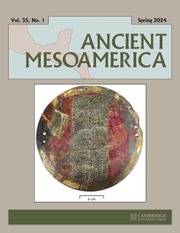No CrossRef data available.
Article contents
Late Postclassic Lowland Maya politico-ritual architecture: Temple assemblages and Zacpeten
Published online by Cambridge University Press: 13 September 2024
Abstract
Late Postclassic lowland Maya civic-ceremonial masonry architecture appears in two main configurations—temple assemblages and basic ceremonial groups—first identified at Mayapan. Around the Peten lakes, these two architectural complexes have been tied to northern immigrant Kowojs and Itzas, respectively, and their distributions map the varying control over the lakes by these two ethnopolities. Temple assemblages exhibit considerable variation in their structural components and arrangements throughout the lowlands, but they have not been studied comparatively. Here, we examine 14 temple assemblages at 12 lowland sites. We consider one of the two assemblages at Zacpeten (Sak Peten), Group A, to have been built by Kowojs, who asserted their identity and earlier (Late/Terminal Classic) ties to the site by reusing carved monuments. “Blended” assemblage Group C is more difficult to parse, but reflects cosmo-calendrical principles of statecraft and the builders’ and users’ broader ties to Mayapan and Topoxte.
Resúmen
La arquitectura de mampostería cívico-ceremonial maya de las tierras bajas del Posclásico Tardío aparece en dos configuraciones principales, grupos ceremoniales básicos y conjuntos de templos, identificados por primera vez en Mayapan, Yucatan, Mexico. Alrededor de los lagos de Peten central (Guatemala), los dos complejos arquitectónicos han estado vinculados a inmigrantes itza y kowoj, respectivamente, y sus distribuciones mapean el control variable sobre las poblaciones de los lagos por parte de estas dos etnopolíticas. Los conjuntos de templos exhiben una variación considerable en sus componentes y sus disposiciones estructurales en sitios de las tierras bajas, pero no han sido estudiados comparativamente. Aquí, examinamos 14 conjuntos de templos en 12 sitios de las tierras bajas. Consideramos que uno de los dos conjuntos en Zacpeten (Sak Peten), Grupo A, fue construido por los Kowojs haciendo una declaración sobre su identidad y su función, como también se ve en los artefactos. Los constructores del Grupo A afirmaron enlaces anteriores (Clásico Tardío/Terminal) con el sitio mediante la reutilización de monumentos tallados, así como con Tikal. El conjunto “combinado” del Grupo C es más difícil de analizar, pero refleja ideales cosmo-calendáricos del arte de gobernar y los vínculos más amplios de los constructores y usuarios con Mayapán y Topoxte.
- Type
- Research Article
- Information
- Copyright
- Copyright © The Author(s), 2024. Published by Cambridge University Press



